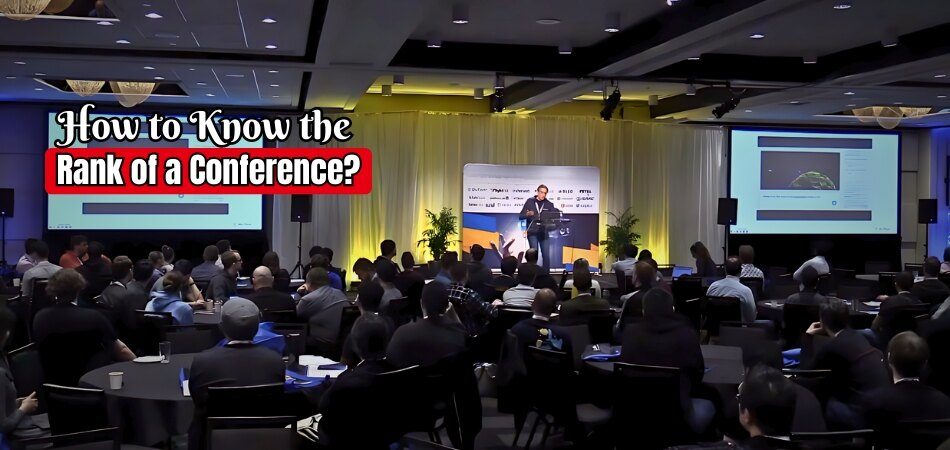Conference rank shows how trusted and valuable a conference is in research. It reflects the importance of the work presented and the recognition it receives. Many people often think about how to know the rank of a conference?
Check a conference’s rank by using trusted academic sources. Search the CORE ranking for computing (A*, A, B, C), use Google Scholar Metrics for h-index data, and check Scopus or SCImago for indexing. Look at acceptance rates, past keynotes, organizers, and citation impact to judge quality.
Do you also want to know how different ranks, indexes, and reviews shape the reputation of a conference? If yes, then keep reading because this article explains everything you need to understand about conference ranking in detail.
How to Know the Rank of a Conference?
A conference rank simply means how important and trusted a conference is compared to others. It matters because it shows the quality of research shared there. Knowing this helps you choose better. Let’s understand more about it.

Meaning & Value
Instead of guessing, use rank to understand a conference’s standing. It reflects selectivity, peer trust, and the venue’s real influence. Strong ranks often signal careful review and wider readership. This matters because good placement improves discovery, increases citations, and supports resumes and future opportunities.
CORE Grades
For computing fields, CORE grades conferences as A*, A, B, or C. These grades reflect selectivity and reputation across computer science areas. You can search the public CORE list by venue name. Note that CORE applies only to computing, not other research disciplines.
Scholar Metrics
On Google Scholar Metrics, venues show an h-5 index and h-5 median. The index counts how many recent papers reached at least that citation number. The median shows a typical impact among those papers. Smaller or newer conferences may be missing, so treat absence with caution.
Scopus Indexing
Visibility improves when proceedings appear in a trusted series or database. Look for IEEE Xplore, ACM Digital Library, or Springer’s LNCS series. Check Scopus for coverage and use SCImago to view series metrics. And if you’re planning for global events like international conferences in Canada, the USA, or other countries, knowing indexing helps you decide. Tools such as the SCImago conference ranking make it easier to compare events and choose the ones with higher impact and visibility.
Acceptance & Review
Some conferences share acceptance rates on websites, calls, or reports. Lower percentages can indicate stronger selectivity, but they never prove quality by themselves. Also, check review style, like double blind with clear rules. Combine rate, review details, and indexing signs before trusting a venue’s standing.
Organizers & Committee
Backing from real universities, societies, or publishers adds clear credibility. Look for a named chair, a full committee list, and links to profiles. Good venues publish conflict rules and recusal steps. Such transparency reduces bias, encourages fair reviews, and helps authors trust outcomes and timelines.
Keynotes & History
Past programs reveal stability and community respect over many editions. Search archives for keynote speakers, video recordings, and published proceedings. Consistent scheduling and steady locations often show reliable organization. A pattern of strong invited talks suggests the event nurtures quality discussions and attracts research audiences.
Paper Citations
Impact appears in how papers are cited after publication. Pick three to five recent papers from the venue and search Google Scholar. Note citation counts and who is citing them. If several papers gain steady citations, the conference likely reaches readers and influences later work.
How Do I use CORE for Conference Ranking in Computing?
When you want to understand how good or reliable a conference is in the computing field, one of the best tools is the CORE ranking system. It helps compare conferences across areas and grades them. Keep reading to know more about it.
Grade Levels
CORE uses grades like A*, A, B, and C to rank conferences. A* means the conference is considered the very best and highly selective. A is also excellent, while B shows good quality but is less competitive. C still counts, but signals lower reputation and selectivity.
Double A Star
Sometimes you may notice people talking about understanding the AA* conference ranking. This is not an official CORE grade but is often used informally to describe elite conferences above A*. It’s a shorthand way to point to the most respected venues.
Search Method
To find rankings, you can visit the official CORE portal. You can type in the conference name, acronym, or even by research field. The search will show the grade, field category, and the year of evaluation. It’s very straightforward to use.
Scope Limits
CORE mainly covers computer science, information systems, and related areas. If a conference is outside these areas, it might not appear in the rankings. That means it’s helpful but not complete, so don’t rely only on it for all fields.
Practical Use
Researchers and institutions use CORE to judge where to publish or which conferences to attend. It gives a clear signal of reputation and quality, but it should be used with other factors like scope, audience, and personal research goals.
How Do Google Scholar Metrics Help With Conference Ranking?
Google Scholar Metrics are citation-based measures that show how much impact a journal or conference has had in recent years. They are often used to compare different publication venues. The two main indicators are the h-5 index and the h-5 median.
h-5 Index
- The h-5 index is like the normal h-index, but only counts papers published in the last 5 years.
- A conference has an h-5 index of h if h papers published there in the last 5 years each received at least h citations.
- Example: An h-5 index of 40 means that 40 papers from that conference have at least 40 citations each in the last five years.
- Why it matters: A higher h-5 index shows that the venue has more highly cited and widely read papers recently.
h-5 Median
- The h-5 median looks at the same top h papers but takes the median number of citations among them.
- It helps show how strong the average impact is, not just the minimum to reach the h-5 index.
- Example: If the top 40 papers (from above) had citation counts ranging from 40 to 200, the median might be 85. That means the “middle” paper of the top set had 85 citations.
- Why it matters: It gives more balance by showing typical influence, not just the lower edge of the h-5 index.
Where to Find These Metrics
- You can see them directly on Google Scholar Metrics.
- They are listed for journals and conferences under different subject categories.
- Each venue shows its h-5 index and h-5 median side by side.
Limits of Google Scholar Metrics
- Only covers the last 5 years (short-term picture, not long-term reputation).
- Focuses on citations only, without considering review quality, acceptance rates, or prestige in the community.
- The data is limited to what Google Scholar has indexed, which might miss some publications.
A higher h-5 means the conference has stronger recent citations, showing it has been publishing papers that other researchers are actively using and citing.
How Do Organizers and the Program Committee Affect Conference Ranking?
Choosing a conference can sometimes feel confusing and uncertain. Many events look professional online, but not all are reliable. The way organizers and committees work plays a big role in quality. Keep reading to learn what details affect trust and ranking.
Society Support
Backed events from real societies tend to earn stronger trust. These groups care about their name and follow proper reviews. Check for a society logo, registration details, and previous years. Stable support attracts good papers and reviewers, which usually helps rankings grow.
University Ties
Hosting by a university adds clear credibility to an event. Departments use strict standards for committees, deadlines, and publishing. Verify the event appears on the university’s official site. Real campus backing improves review fairness and visibility, which often leads to higher rankings.
Program Committee
Transparent lists of program committee members signal expert review. Look for names, affiliations, and roles for chairs and members. Search a few profiles to confirm active research. Qualified reviewers raise paper quality and citations, and their reputations usually influence the conference’s ranking.
Policy Clarity
Written rules show how submissions and reviews are handled fairly. Good pages list deadlines, plagiarism checks, conflict rules, refund terms, and appeals. Clear steps reduce bias and rushed decisions. Strong policies improve author trust and outcomes, which support better records and rankings.
Real Contacts
Direct contact details help you test if organizers are responsive. Look for emails with official domains, a physical office address, and phone hours. Send a simple question and check the reply speed. Helpful, timely support builds confidence and reflects well in public rankings.
What Red Flags Warn About Weak Conference Ranking?
People want conferences that are real, fair, and worth their time. Some events look shiny but hide weak standards. A few checks can save money and effort. Curious about the warning signs that matter most? Keep reading.
- Spam Invites: Sudden emails pushing fast submission or payment often show poor quality control, especially when personalized details are wrong and the message reaches unrelated departments or disciplines.
- Unclear Venue: Missing street address, shifting city names, or only “online or onsite” without specifics suggests risky organization and weak planning that can collapse near event dates.
- Fake Names: Program committees listing unknown scholars with no profiles, or real professors misnamed or misaffiliated, signal deception and a lack of transparent academic leadership and accountability.
- No Past Proceedings: Absence of archived papers in recognized libraries, society pages, or publisher sites indicates little scholarly record, making citations and verification difficult for future readers and institutions.
- Vague Indexing Claims: Statements like “indexed by major databases” without links to official entries, or mismatched conference titles, usually mean unreliable promises and possible indexing rejections later.
- Overly Broad Topics: Call for papers that accept nearly every subfield at once shows weak focus, diluted peer review, and a goal centered on volume rather than meaningful technical contribution.
- Unrealistic Deadlines: Guarantees of acceptance within days, rolling reviews without details, and immediate publication promises suggest cursory checks that ignore originality, ethics, and standard referee practices.
Strong conferences are clear about venues, committees, and archives. Reliable events provide verifiable indexing pages with consistent names. Balanced scopes and sensible timelines protect review quality. Use these signs together to decide confidently and skip risky invitations, since they matter just as much as official conference rankings when choosing where to participate.
How Do I Compare Conference Rankings Across Similar Conferences?
Comparing conference rankings works best when you place numbers side by side. Tables help you see which venue performs stronger or weaker quickly. The h-5 index and h-5 median are the most useful measures. Adding them to one table makes the differences easy to understand.
Peer venues
When you want to compare, pick three or four similar venues. Choose conferences from the same subject area for fairer numbers. Different subjects can have very different citation counts and patterns. This keeps the table meaningful and useful for simple comparisons.
Key metrics
The h-5 index tells how many papers gained strong citation numbers. The h-5 median shows the middle citation count among the top papers. Together, they show both the spread and strength of recent conference papers. Understanding these numbers also explains the significance of conference rankings in research fields.
Sample table
Here is an example table with three sample conferences for clarity:
| Conference Name | h-5 Index | h-5 Median |
| Conference A | 60 | 95 |
| Conference B | 55 | 80 |
| Conference C | 48 | 70 |
Key limits
Numbers are updated only once a year by Google Scholar Metrics. They cover only the last five years, not the longer conference history. Different subjects have different citation speeds, so compare within fields. Always mix numbers with expert opinion for better-balanced judgments.
Does a Low Acceptance Rate Always Mean Strong Conference Ranking?
A low acceptance rate is often seen as a sign of conference quality, but it does not always mean a strong ranking. Some conferences accept fewer papers simply because they receive many submissions, not because every paper is outstanding. Strong ranking depends on impact, citations, and recognition within the research community.
Acceptance rate must be read alongside other signals to get the full picture. High citation counts, respected editorial or program committees, and a consistent history of good research make a bigger difference. A conference can be selective but still have limited global influence if its papers are rarely read or cited. These factors matter most when ranking conferences fairly and deciding which ones truly carry weight in the academic or professional world.
There are also exceptions where conferences with higher acceptance rates maintain strong reputations. This happens when the venue publishes high-quality papers with solid research value that the community respects and cites. Balance matters, so it is best to use acceptance rate with citations, committee reputation, and history.
FAQs About How to Know the Rank of a Conference?
Many people wonder how to judge if a conference is really strong or just average. Conference rank is not always obvious, but asking the right questions makes it clear. These FAQs explain important points in simple words to guide your choice, including how to check conference ranking before you decide to attend.
What is the Difference Between Conference Rank and Journal Rank?
Conference rank measures how important and trusted a conference is, while journal rank shows the status of journals. Conferences are usually about live presentations and networking, but journals focus on long-term publication. Both matter, but they serve different purposes.
How Does Conference Location Affect Ranking?
The city or country itself does not directly change the rank. However, big conferences in strong academic hubs often attract better researchers. This improves paper quality and visibility. So, location can indirectly influence the conference’s importance and ranking.
Can Sponsorship Improve Conference Ranking?
Sponsorship from big tech companies or trusted universities adds value. It shows the event is respected by serious groups. This often brings more experts and better submissions. While not the only factor, sponsorship can strengthen credibility.
Why Do Some Conferences Change Ranking Over Time?
Conference rank is not fixed forever. If quality papers and respected researchers keep attending, the rank can improve. But if reviews become weak or attendance drops, the rank may fall. Community trust decides if the event stays important.
How Do Conference Proceedings Affect Ranking?
Proceedings are the official collection of accepted papers. If these are published by strong publishers like the IEEE conference ranking or the ACM, the ranking improves. Proceedings add visibility and indexing, making papers easier to find. Without them, credibility may weaken.
Do Awards at Conferences Impact Their Rank?
Awards like “Best Paper” or “Best Student Paper” highlight recognition for quality. They show reviewers take judging seriously. Regular and fair awards attract stronger papers. Over time, this can help improve the conference’s reputation and ranking.
How Does Peer Review Style Impact Conference Rank?
A transparent review system builds trust. Double-blind reviews, where both sides remain anonymous, are often seen as fairer. Conferences with strong review practices usually publish better papers. This directly improves the perception and rank of the event.
Can Conference Rank Differ Across Subjects?
Yes, different fields have different standards. A top-ranked conference in computing may not be as big in biology. Rankings depend on subject communities and citation habits. Always compare within the same subject area for fair results.
Conclusion
Knowing the real value of a conference means checking many things together, like citations, acceptance rates, committees, indexing, and history. This balanced view helps you see trust and influence clearly, and that is the short answer to how to know the rank of a conference.
As you plan your research path, always compare venues carefully, read their past proceedings, and confirm their visibility in trusted databases. Look beyond numbers, value real credibility, and choose wisely. Wishing you success in finding the right conferences for your work.








